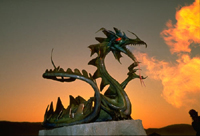China protests against Western image of fire-breathing monster dragon
Fire-breathing monster or supernatural symbol of harmony? When it comes to the dragon, East and West don't see eye-to-eye.

Chinese culture mavens alarmed by the prevailing Western image of the dragon as a terrifying, fire-breathing monster are urging that their country seek a less intimidating national symbol, provoking a debate over the whole issue.
What to do?
The latest brouhaha arose after a newspaper, the Shanghai Morning Post, cited a local professor, Wu Youfu, as saying that the dragon's image in the West was too negative.
Wu was not immediately available for comment. But the report provoked a flurry of commentary.
"I saw some Western media used the word 'dragon' to describe terrorists. Also, in the Harry Potter films, dragons represent evil ogres," Huang Ji, a professor at East China Normal University, said in a phone interview Tuesday.
Huang proposes swapping the word "loong" for dragon, when translating the concept from Chinese. The standard Chinese word for the mythical Chinese creature known in the West as a dragon is "long," pronounced with a hard "o" sound as in show, the AP says.
"It's a good idea to separate the image of the dragon and the Chinese 'loong,"' Huang says, who set up a Web site: www.loong.us to help educate foreigners about the issue.
He said China didn't choose the dragon as a mascot for the 2008 Beijing Olympics largely because it didn't want people to associate the event with a fire-breathing monster. Instead it created five cartoon mascots based on the panda, Tibetan antelope, fish, swallow and Olympic flame.
Whether you call it a "long" or a "loong," in Chinese mythology the dragon is viewed as a supernatural creature whose main task is to foster harmony by bringing life-giving rains.
The image of the dragon transfuses Chinese art and architecture. Dragon dances are a popular festive ritual. The Chinese traditionally call themselves the "sons of the dragon;" millions have "long" as part of their names.
But according to tradition the Chinese dragon is no fire-breathing monster. It is said to be composed of the parts of nine other creatures, including the eyes of a rabbit, ears of a cow, head of a horse or camel and body of a snake.
Even though Chinese dragons are said to be able to fly, they have no wings.
One scholar, Huang Shouyu, proposed the "pig" as a possible substitute, given the animal's reputation in China for being clever, wise and brave, the China Economy Net said. But that idea is likely to offend many, especially the country's large population of Muslims, who view the pig as unclean.
Most of the media and public commentary on the issue favors the dragon, regardless of its mythical image in the West.
"Well, the word panda has a nice ring to it, but you'd better watch out or Westerners will confuse it with Prada," a contributor to the Sina.com bulletin board wrote.
A report on the Web site of the official Xinhua News Agency said some experts were seeking state funding for research on improving China's national image, possibly with a new symbol.
"We should avoid wasting the taxpayers' money on such frivolous research topics," it said.
Subscribe to Pravda.Ru Telegram channel, Facebook, RSS!





